One of the biggest developments in the world of diving this year was the news that Apple had added recreational scuba diving to its latest product, the Apple Watch Ultra, via the Oceanic+ app, which has been launched today (28 November 2022).
The Apple Watch Ultra (£849) is the most-rugged and capable Apple Watch yet, specifically designed for the outdoor adventurer and watersports enthusiast. It has a 49mm case made from aerospace-grade titanium, a sapphire front crystal which showcases a stunningly-bright always-on retina display, and three easily interchangeable bands, including the robust Ocean band as fitted to our unit, which is designed for use in the water. The bands can be swapped out in seconds, and you can get – as we did – an extended Ocean strap for use with drysuits, which is £49.
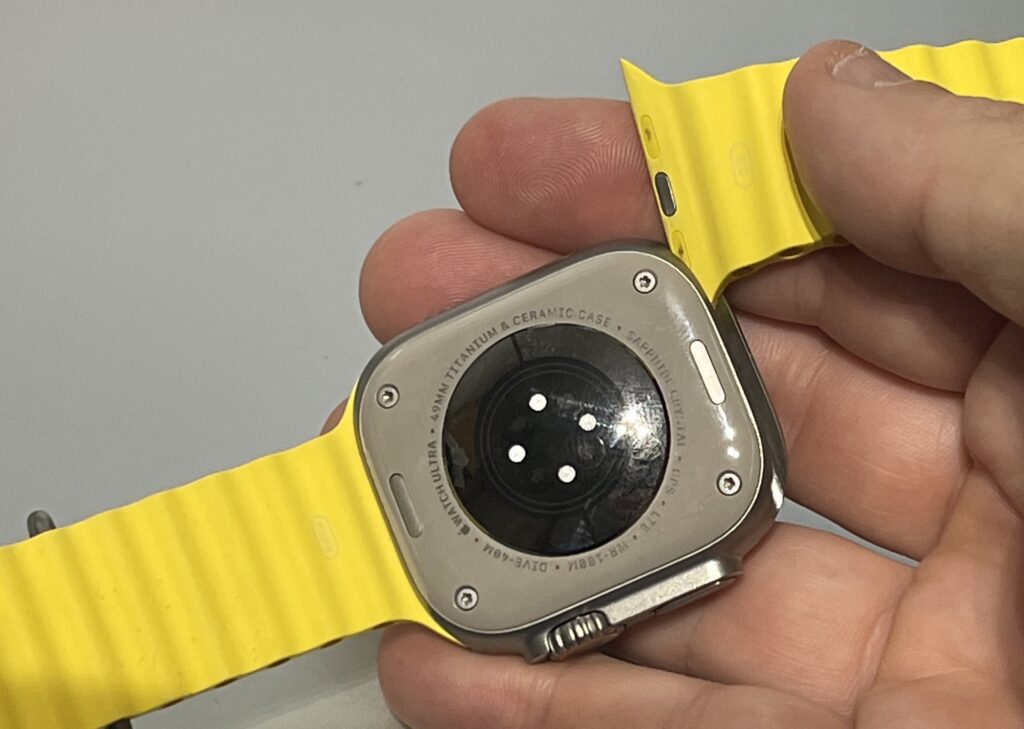
Being an Apple Watch, the Ultra has a seemingly endless array of features, from walking, running, cycling, swimming, triathlon, rowing, yoga, pilates, tai chi, to blood oxygen sensor, ECG app and even fall detection. It also has a nifty compass, an extremely loud siren, and dual-frequency GPS, and straight out of the box it has a ‘depth’ mode, which will show your depth, time, etc, while freediving or diving. There is so much this thing is able to do, your best bet is going on to the Apple website and seeing for yourself all of its above-water features.
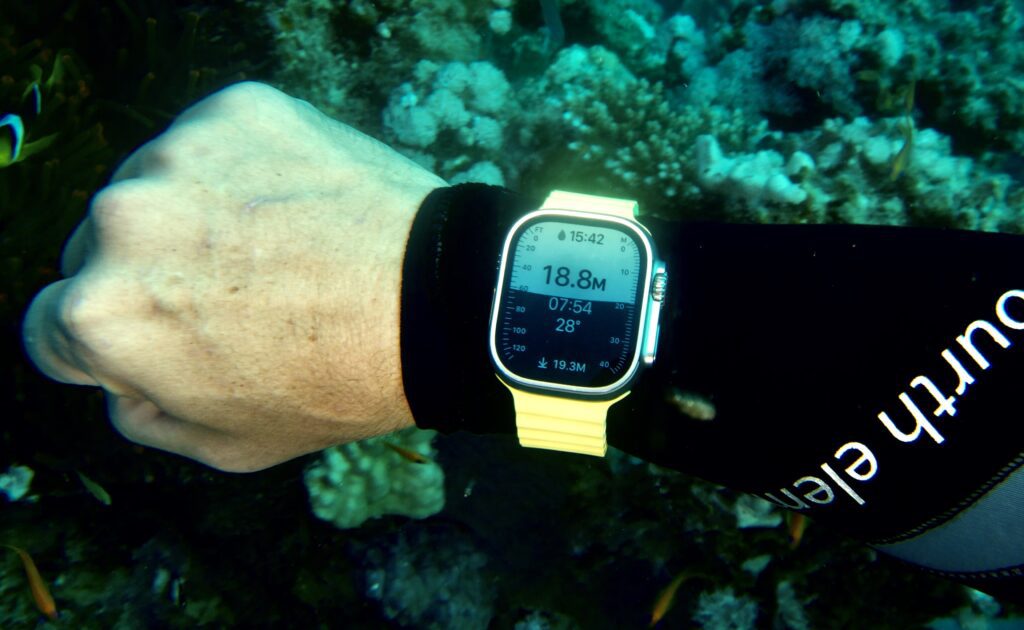
Diving the Apple Watch Ultra
So, the Apple Watch Ultra is an extremely capable smart and fitness watch, but we are here for the diving. So, what is the Oceanic+ app (launched today – 28 November 2022), which unlocks all of the dive computer features, actually like? Well, as you’d expect from anything involved with Apple, it is very user-friendly and intuitive, and as Huish Outdoors know a thing or two about diving, it uses the tried-and-tested Buhlmann decompression algorithm. You can choose between snorkelling and scuba mode, done by a simple tap of the screen in Dive Settings.
Snorkelling Mode
In snorkelling mode, on the screen you get your maximum depth, the number of snorkelling sessions you have done, your last ‘dive’, the number of dives, and the water temperature. Scroll up on the digital crown on the side and you get your compass, but you can’t set any headings.
Scuba Mode
In scuba, which is what we are more interested in, you have the actual dive mode, No Deco Planner, Logbook, and Settings.
Dive Settings
Let’s jump into Settings first. Again, all very user-friendly – you navigate around by tapping the screen and scrolling the digital crown. You can see and edit your account, and in General Settings, you can choose between Metric (Centigrade, Metres and Kilogrammes) and Imperial (Fahrenheit, Feet and Pounds).
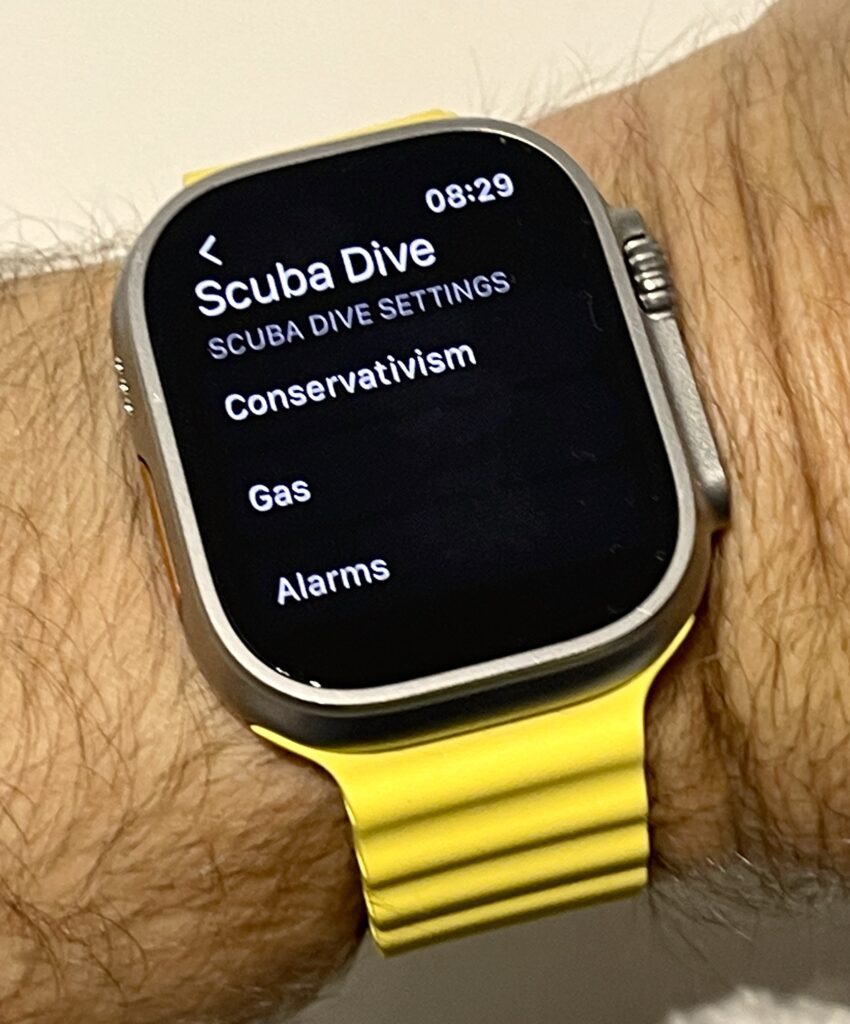
In Dive Settings, once into Scuba Settings, you can go into Conservatism – select the gradient factors conservatism level, from default (70/85), to more conservative (65/80), to most conservative (60/75), or even add your own custom level. You can also select the PPO2 percentage – it is 1.4 as default, and you can go lower than this but cannot go higher – so no setting your PPO2 to 1.6 to gain a few extra metres on your nitrox MOD!
Gas Setting
Then there is your Gas Setting, where you can choose between air or nitrox. The Apple Watch Ultra will handle nitrox from 22-40 percent, perfect for recreational divers with their nitrox ticket.
Alarms Settings
Finally, you have your Alarms settings, where you can set alarms for target dive time, target depth, low no deco, and minimum temperature. It is a simple matter to toggle these on or off. If you exceed or reach any of your target settings, the bottom half of the screen clearly shows this, be that vivid yellow for reaching your target depth, for example, or bright blue for when the water temp drops below your minimum temperature.
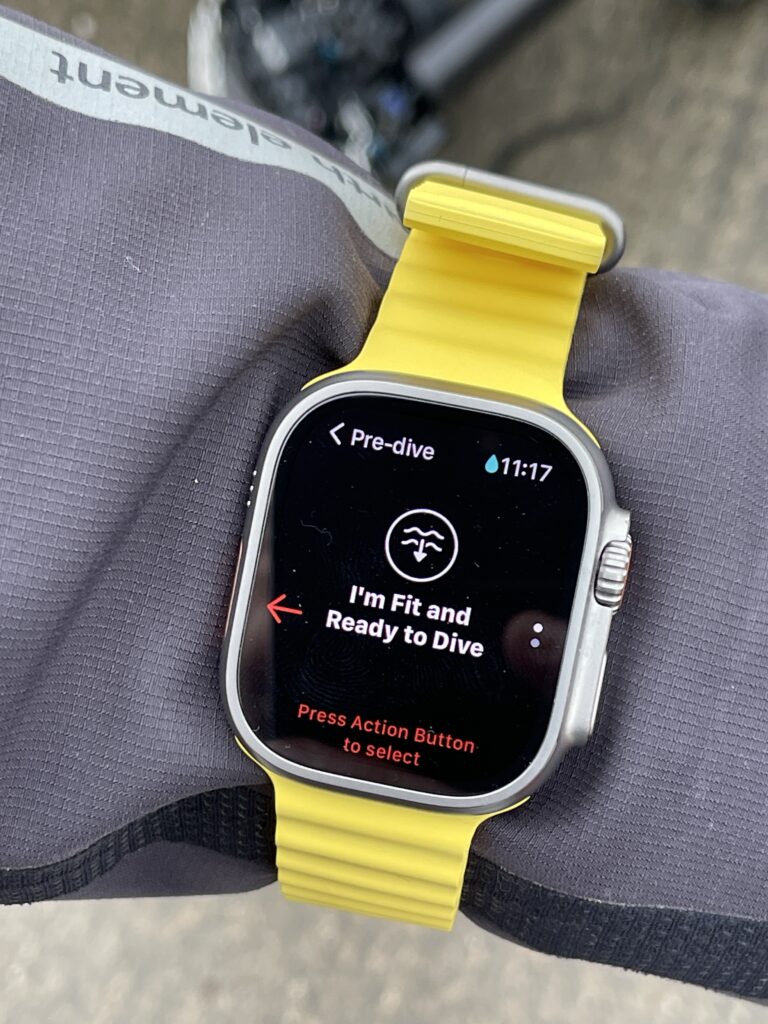
Dive Now – Dive Screen
Right, so that’s the computer all set up – let’s go diving! When you hit the Dive Now on the app, you get a screen with the statement I’m Fit and Ready to Dive. You have to press the Action Button on the left-hand side to instigate being ready to dive.
This brings you on to the dive screen, and it is very clear and easy to navigate. Your current depth is at the top, your no deco time is next, with a green dotted line beneath – this will go down and turn yellow as your no deco approaches its limit, giving you a great visual cue as well as the countdown of the numbers.
Below this on the home screen you have your dive time, your minutes to surface, and finally the temperature.
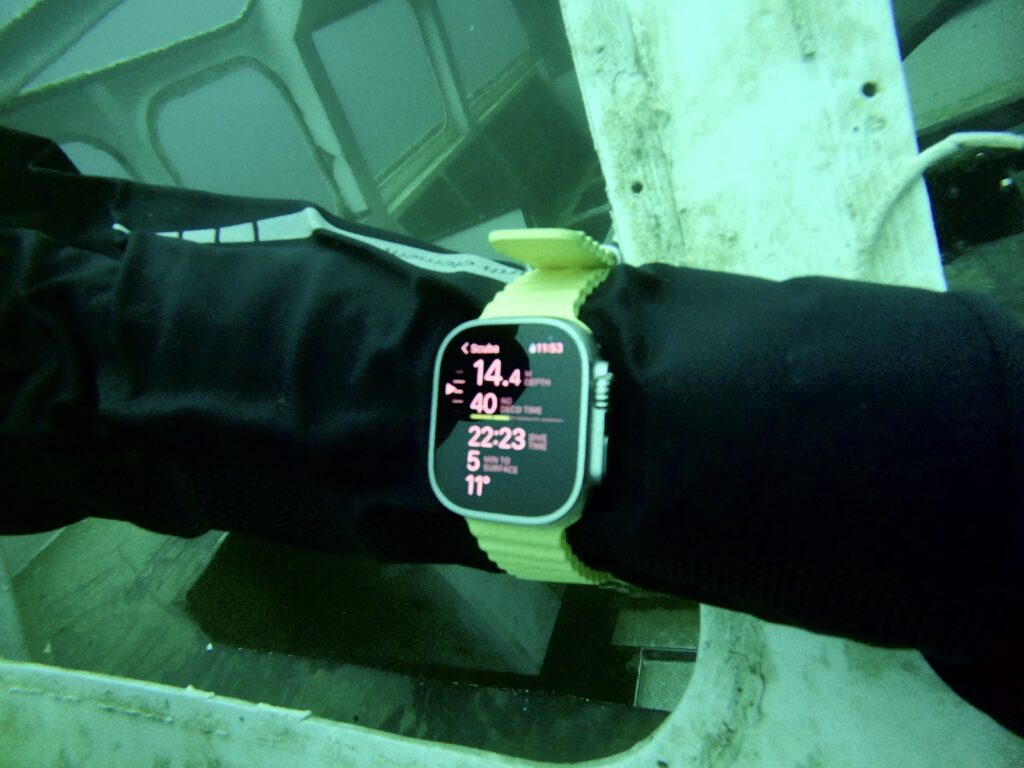
One scroll up on the digital crown and you replace these bottom three with your maximum depth, your ascent rate and your battery percentage.
Scroll again and these three are replaced by your digital compass. You press the Action Button to set a heading, and press it again to remove it.
A final scroll displays your gradient factor settings, whether you are on air or nitrox, and your maximum PPO2 level.
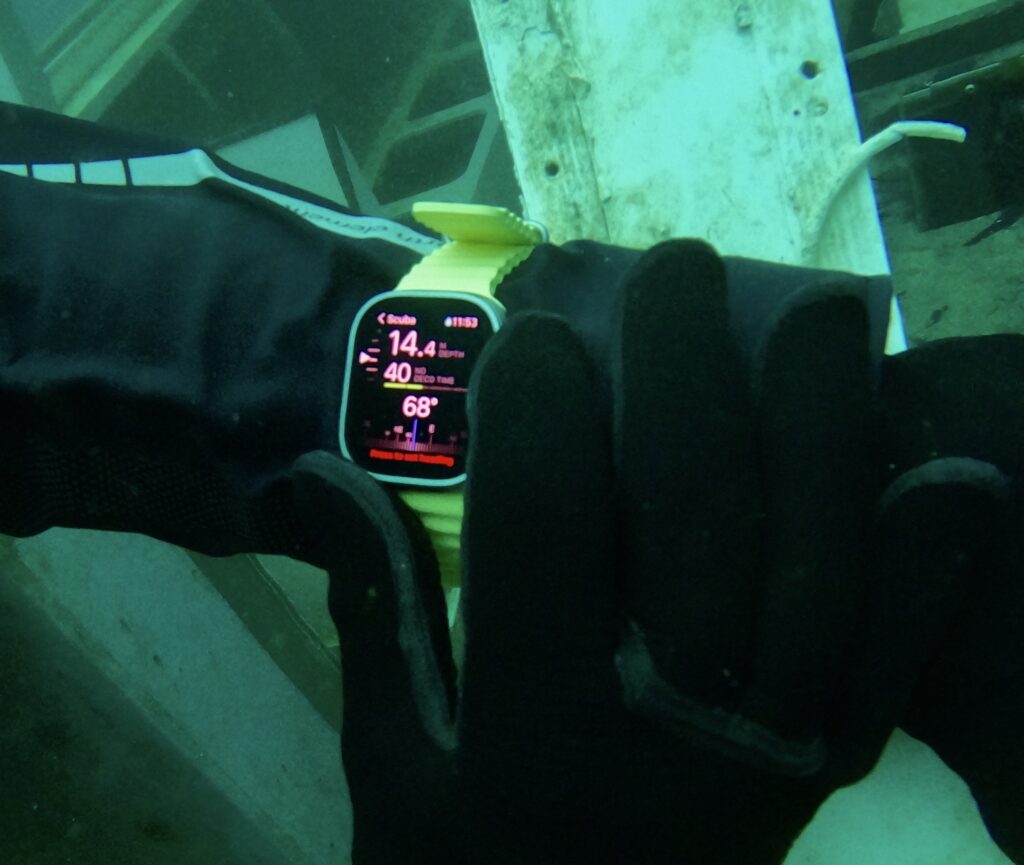
The dive screen is very legible even in low-visibility or night-time conditions, and I had no difficulty pressing the Action Button or scrolling the digital crown when wearing both drygloves and thick neoprene gloves in single-digit temperatures.
I liked the fact that if you do start to ascend too fast, for instance, the computer does all that it can to alert you to your violation, including the bottom half of the screen having a red warning with ‘slow down’ on it, as well as the Ultra vibrating, which can be felt through a drysuit.
Likewise, when you arrive at your safety stop, the bottom half of the screen goes yellow, it states ‘safety stop’, and you get the strong vibration along with your usual three-minute countdown.
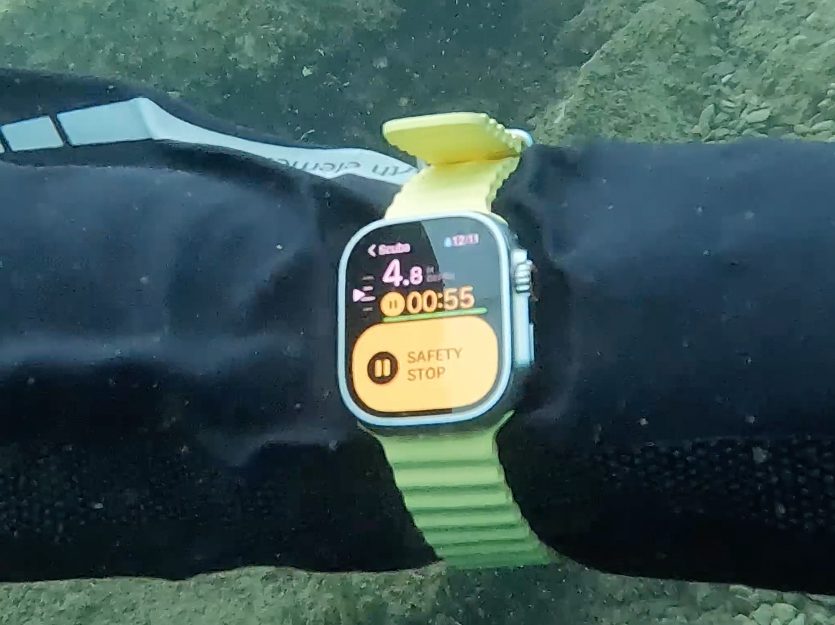
All this just adds to the simple-to-use and intuitive nature of the Oceanic+ app on the Apple Watch Ultra. Recreational divers want a computer that is easy to get used to, clear in its warnings, and with all of the features they will need. It handles recreational nitrox mixes, so that is covered, and if you do stray into decompression, it will give you all the necessary stops to get you safely to the surface. We pushed the Ultra into decompression, and as we went past our NDL, the bottom-half of the screen flashed up with a deco warning as well as vibrating, so there was no way you would miss it. It then showed what depth we would need to stop at, and for how long. We ran it up to five minutes of deco, but by the time we had made a slow ascent up to 6m, it had cleared and was back in ‘normal’ no-deco mode.
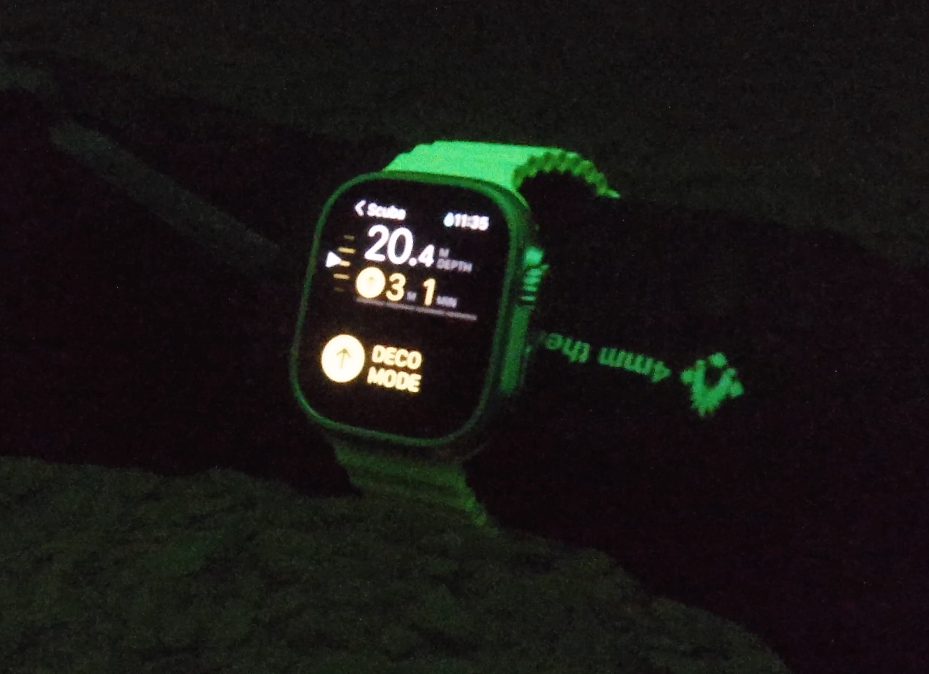
Battery Life
Battery life is not bad at all, especially given that always-on display. It can last for up to 36 hours in normal use, but you will still get over 12 hours even utilising more of the features. I did two 50-minute dives in a day with a fully charged Ultra and it still had more than 74% battery life remaining when I surfaced from the second dive. Regardless of battery usage, it isn’t an issue, as the Apple Watch Ultra’s lithium ion battery charges extremely quickly on its supplied charging station.
What is a Dive Computer?
A dive computer, personal decompression computer or decompression meter is a device used by an underwater diver to measure the elapsed time and depth during a dive and use this data to calculate and display an ascent profile which according to the programmed decompression algorithm, will give a low risk of decompression sickness. Read more about Top 10 Dive Computers 2022
Comparison with Dedicated Dive Computers
Suunto D5
Well, in terms of the diver it is aimed at, its obvious rival is the Suunto D5. This has a colour screen and can handle all that the Ultra can diving-wise, but it doesn’t have any of the smart and fitness watch functionality, and the Ultra screen display is far brighter and easier to read.
Shearwater Research Teric Dive Computer
Next up is the Shearwater Research Teric. This well-regarded dive computer can handle anything you throw at it, right up to sidemount, open-circuit tech and CCR. It has an insanely bright OLED display, and is priced in the vicinity of the Ultra. Now, the Teric display is far brighter than the Ultra, but this comes at a price – battery life is not as good as the Apple. And again, it may have far more dive features, but it is not a fitness/smart watch. It does have air-integration, though.
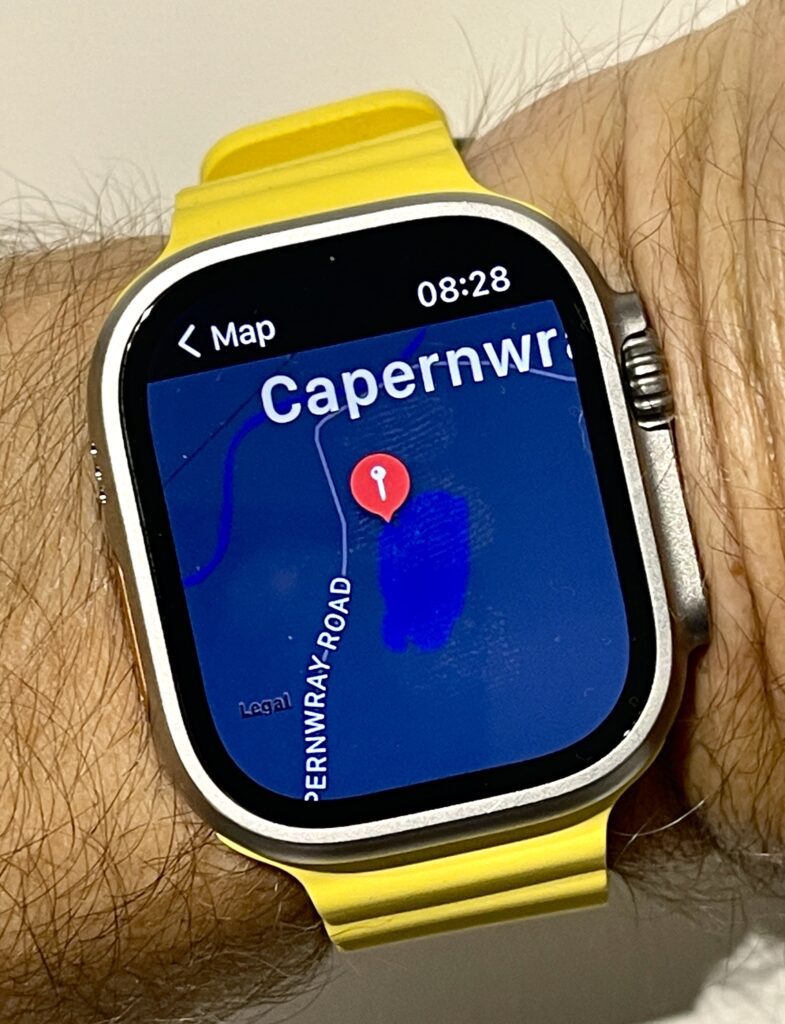
Garmin Descent MK2S/MK2/MK2i
Finally, there is its nearest rival in terms of functionality – the Garmin Descent MK2S/MK2/MK2i. Both are smart/fitness watches, both have colour screens, both are rechargeable, and both are full-function dive computers, however, they are aimed at different people. The Garmin wins on the diving front because it can handle multiple gas mixes, OC tech and CCR, thus appealing to more-experienced divers, but the Ultra screen is far brighter, clearer and easier to read, and the menu and navigation on the Ultra is superior and more user-friendly than the MK2, which is all great for newer divers. The impressive battery life of the Garmins is hard to beat, though.
Final Verdict
I heard some negative remarks across the internet when the news of the Ultra – and the Oceanic+ app – first broke. There were lots of ‘but it doesn’t work beyond 40m’, etc, but at the end of the day, I bet many of the naysayers rarely break 30m, never mind 40m! And if a recreational diver has by some chance headed off below 40m, they have far more issues to deal with than their computer not working. The vast majority of recreational divers out there never stray beyond 30m, so this would cater to them perfectly. However, the Ultra itself is depth-rated to 100m, so who knows down the line what the future holds in terms of potential new app developments.
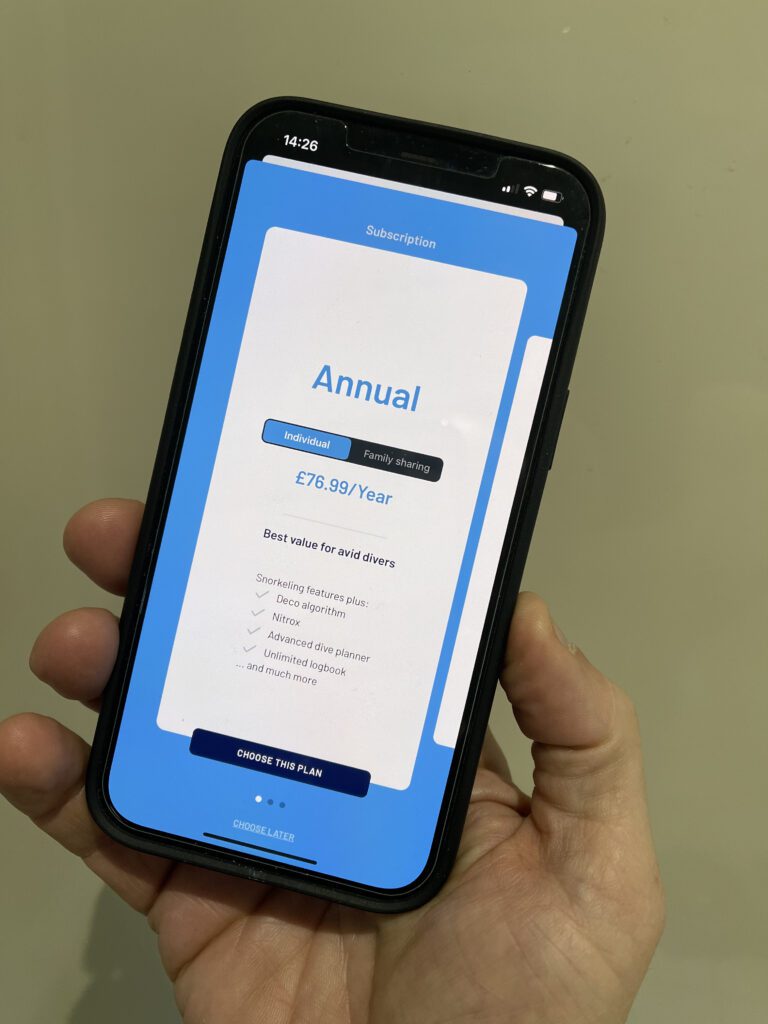
Being an app of this calibre, you have to pay for it – you can get a one-day pass for £4.99, monthly plans start at £8.99, and an annual plan is £76.99. Again, there was much negativity regarding this app-based dive computer approach, but many people are used to downloading and paying for decent apps in this day and age, so I can’t see the issue – £76.99 is not exactly the end of the world in expenditure, and being an app, new features will be added all the time, adding to the functionality of the Ultra as a dive computer alongside its already-impressive smart/fitness watch applications.
This app is already far more than just something which makes the Apple Watch Ultra into a dive computer. Using the app on your phone, you can go into the location planner, drop a pin on a particular location you are set to go diving, and this produces a huge amount of information, including surface temperature, water temperature, wind, UV and tides. And you can see this info for up to three days in advance – ideal for when you are looking at the coming weekend for your next diving jaunt.
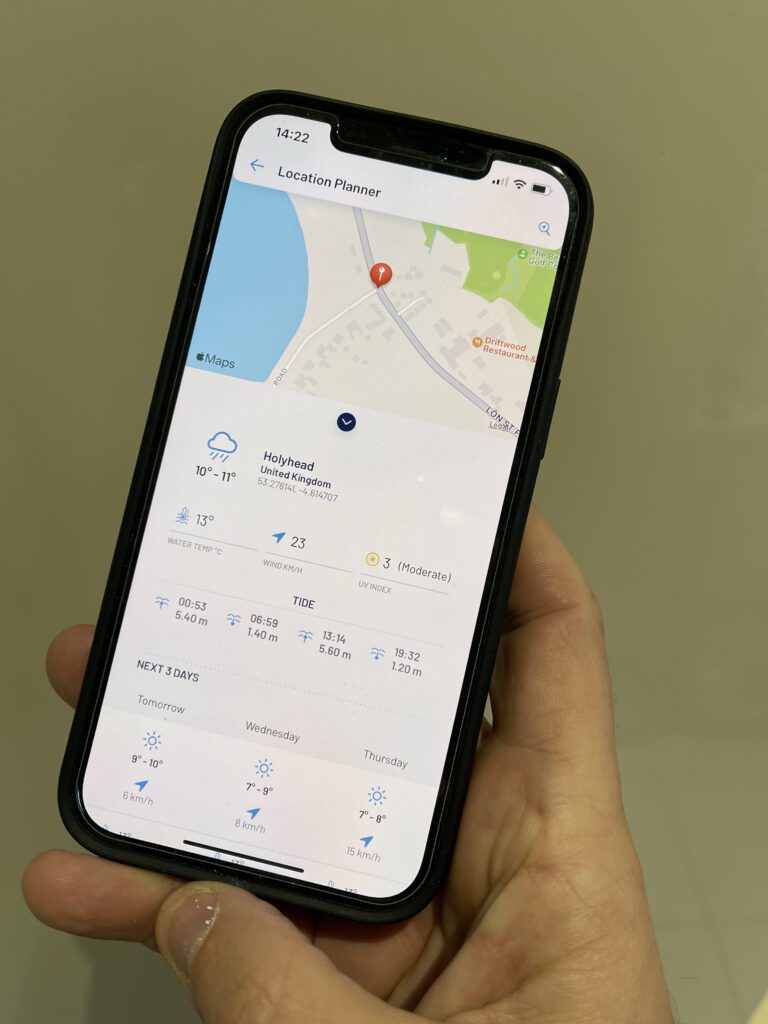
For those that log their dives – I vaguely remember back when I used to do that! – the Apple Watch Ultra syncs all your dive data with your phone, where you can see a map of your entry and exit locations, and graphs of your depth, water temperature, ascent rate and no deco limit. You can then add additional details into this logbook.
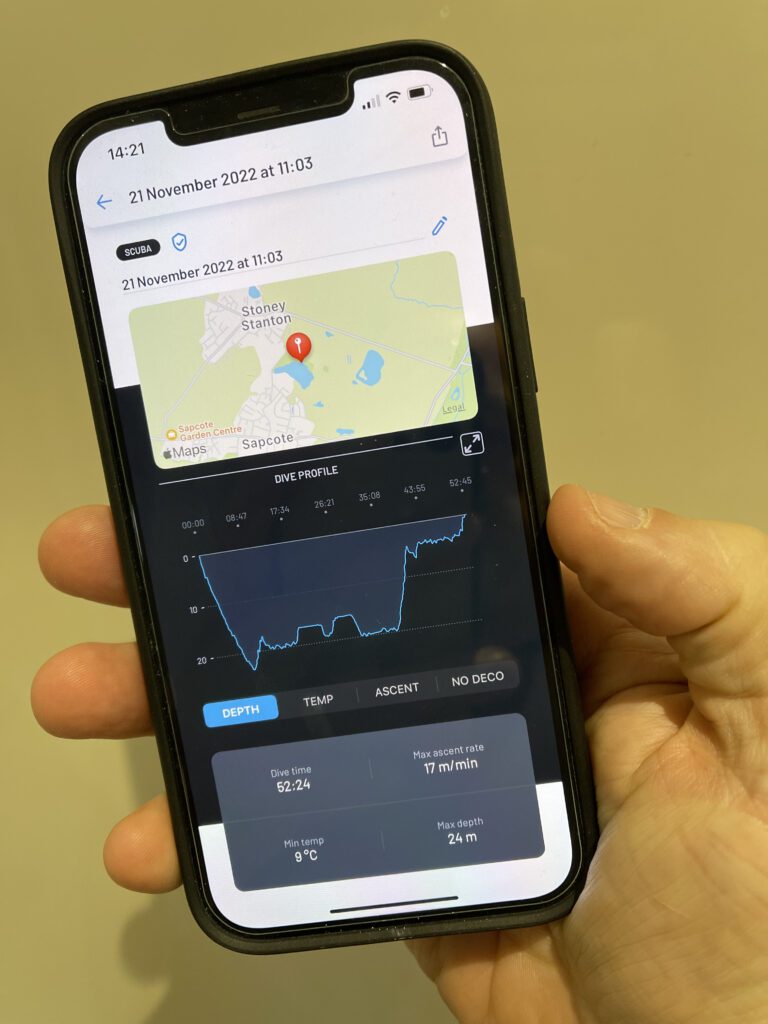
It is going to be interesting to see what an impact the Apple Watch Ultra and the Oceanic+ app have in the coming year and beyond. Considering the company sells in excess of 35 million Apple Watches annually, getting scuba diving in front of even a small percentage of that epic number is huge for the dive industry.
Pros
- Bright, clear screen
- Intuitive menus
- Location planner
- Extended drysuit strap
- Smart/fitness watch features
Cons
- Battery life not as long as some
- Subscription for app
- Dive computer only works to 40m
- No multiple nitrox mixes
- No air integration
WATCH NEXT
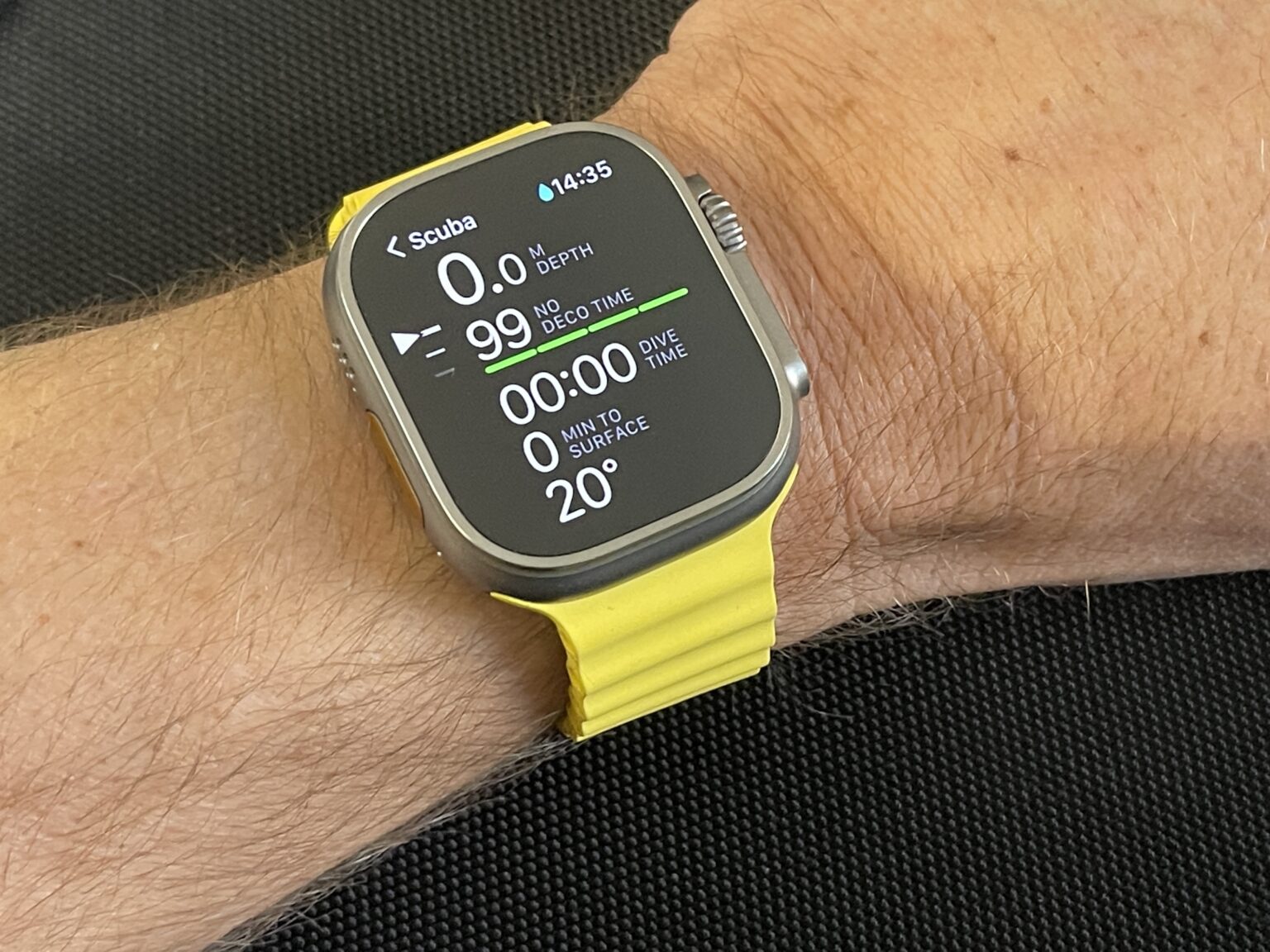


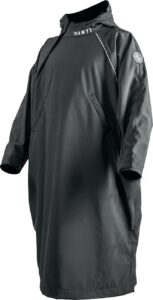
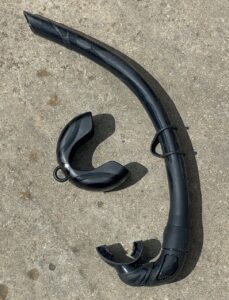
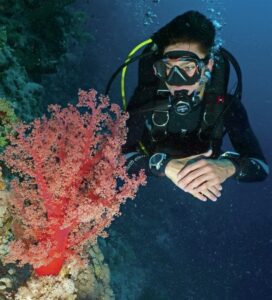


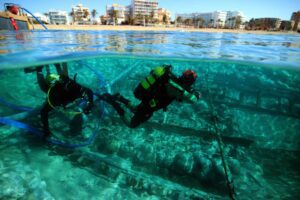
No matter what, a proper dive computer should not “stop working” when it descends below 40m. It simply is inappropriate to say that it’s not a big deal because if a recreational diver descends below that “they have a lot of other problems”. It should not add to that list of problems. It should help remediate them safely. This disqualifies it IMHO as being acceptable.
The app continues working for several minutes beyond 40m, it doesn’t just shut off, and in that entire time the computer is vibrating, sounding an audible alarm, and flashing on the screen. So if someone does venture by accident below 40m, they have time to remedy that situation and head back above 40m – if they ignore all of that and remain below 40m, as I said, they have other problems beyond their dive computer. I also believe that the majority of users of this watch as a dive computer will never go near that 40m ‘limit’.
This article and app is clearly calling out “recreational diving”, at least in this initial version of the app, and if you are doing proper dive planning and know your limits, this “dive computer” is more than adequate, and then some, as noted in the feature and functionality discussion. If one isn’t smart enough to respond to clear and persistent safety warnings starting at the approach of 40M and beyond, it one should probably NOT be in the sport.
Agree 100%
All it does is force you back up above 40m. It keeps recording and calculating so once you ascend it’ll be right back to were it’s supposed to be. Sure it would be great if they added actual tech features but for rec diving I personally feel it’s not a big deal.